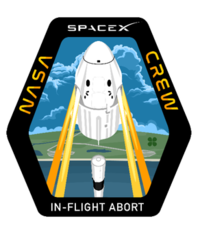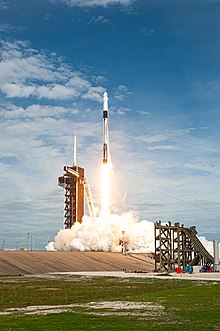Crew Dragon In-Flight Abort Test
 Falcon 9 booster B1046.4 is destroyed by aerodynamic forces, following the ejection of Crew Dragon C205 | |
| Names | SpaceX In-Flight Abort Test |
|---|---|
| Mission type | Technology demonstration |
| Operator | SpaceX |
| Mission duration | 8 minutes and 54 seconds |
| Apogee | 42 km (138,000 ft) [1] |
| Spacecraft properties | |
| Spacecraft | Crew Dragon C205 |
| Spacecraft type | Crew Dragon |
| Manufacturer | SpaceX |
| Start of mission | |
| Launch date | 19 January 2020, 15:30:00 UTC |
| Rocket | Falcon 9 Block 5 (B1046.4) |
| Launch site | Kennedy Space Center, LC-39A |
| Contractor | SpaceX |
| End of mission | |
| Recovered by | GO Searcher (trunk recovered by GO Navigator [2][3][4]) |
| Landing date | 19 January 2020, 15:38:54 UTC |
| Landing site | Atlantic Ocean |
 Crew Dragon In-Flight Abort Test mission patch Crew Dragon flights | |
Crew Dragon In-Flight Abort Test (officially SpaceX In-Flight Abort Test) was a test of the Crew Dragon abort system. The test was conducted on 19 January 2020. It involved the launch of a Falcon 9 from Launch Complex 39A (LC-39A) on a suborbital trajectory, followed by an inflight abort of Crew Dragon at max Q. The capsule successfully escaped, while booster B1046.4 broke up due to aerodynamic forces, as expected.
Background[]
The test was envisioned as a separation and abort scenario in the troposphere at transonic velocities during max Q, where the vehicle experiences maximum aerodynamic pressure. SpaceX Dragon 2 would use its SuperDraco abort engines to push itself away from the Falcon 9 after an intentional premature engine cutoff. The vehicle would reorient, deploy parachutes and soft-land in the Atlantic Ocean. Earlier, this test had been scheduled before the uncrewed orbital test,[5] however, SpaceX and NASA considered it safer to use a flight representative capsule rather than the test article from the pad abort test.[6] The flight would have launched from Vandenberg Air Force Base SLC-4E onboard a modified three engine Falcon 9, which was possibly F9R Dev2.[7]
After the change of plan, the test would have used the C204 capsule from Demo-1, however, C204 was destroyed in an explosion during a static fire testing on 20 April 2019.[8] Capsule C205, originally planned for Demo-2 was used for the In-Flight Abort Test [9] with C206 being used for Demo-2.
Launch[]

Prior to the actual abort test, NASA and SpaceX conducted an all-in simulation of events leading up to an actual crew launch, including crew suit-up and travel to the pad. After delaying for visibility, Falcon 9 lifted off at 15:30:00 UTC, at Kennedy Space Center from LC-39A.
Mission[]
Falcon 9 flew nominally until separation, at which point the Crew Dragon separated and the booster was destroyed. Crew Dragon followed its suborbital trajectory to apogee, at which point the spacecraft's trunk was jettisoned. Draco thrusters were then used to orient the vehicle for the descent. All major functions were successfully executed, including separation, engine firings, parachute deployment, and landing. Dragon 2 splashed down at 15:38:54 UTC just off the Florida coast in the Atlantic Ocean.[10] The Dragon C205's unpressurized trunk section survived Reentry and was recovered by GO Navigator in more or less intact condition, being the only dragon's trunk to survive a reentry and to be recovered successfully.[11][12][13]
See also[]
References[]
| Wikimedia Commons has media related to SpaceX In-Flight Abort Test. |
- ^ https://spaceflightnow.com/2020/01/14/video-preview-of-dramatic-crew-dragon-in-flight-abort-test/ Spaceflight Now 4 January 2020 Retrieved on 3 March 2020
- ^ "SpaceX surprises after recovering spacecraft 'trunk' in one piece". Teslarati. 22 January 2020. Retrieved 22 January 2020.
- ^ "The trunk is on board GO Navigator". Twitter. Retrieved 8 October 2021.
- ^ "Dragon trunk from in-flight abort test is in surprisingly good shape!". Twitter. Retrieved 8 October 2021.
- ^ Foust, Jeff (4 February 2016). "SpaceX seeks to accelerate Falcon 9 production and launch rates this year". SpaceNews. Retrieved 21 March 2016.
Shotwell said the company is planning an in-flight abort test of the Crew Dragon spacecraft before the end of this year, where the vehicle uses its thrusters to separate from a Falcon 9 rocket during ascent. That will be followed in 2017 by two demonstration flights to the International Space Station, the first without a crew and the second with astronauts on board, and then the first operational mission.
- ^ Siceloff, Steven (1 July 2015). "More Fidelity for SpaceX In-Flight Abort Reduces Risk". NASA. Retrieved 19 June 2016.
In the updated plan, SpaceX would launch its uncrewed flight test (Demo-1), refurbish the flight test vehicle, then conduct the in-flight abort test prior to the crew flight test. Using the same vehicle for the in-flight abort test will improve the realism of the ascent abort test and reduce risk.
 This article incorporates text from this source, which is in the public domain.
This article incorporates text from this source, which is in the public domain.
- ^ Bergin, Chris (10 April 2015). "SpaceX conducts tanking test on In-Flight Abort Falcon 9". NASASpaceFlight.com. Retrieved 8 July 2020.
- ^ Shanklin, Emily (15 July 2019). "UPDATE: IN-FLIGHT ABORT STATIC FIRE TEST ANOMALY INVESTIGATION". SpaceX. Archived from the original on 18 July 2019. Retrieved 26 January 2020.
- ^ "SpaceX conducts successful Crew Dragon In-Flight Abort Test". NASASpaceFlight.com. 17 January 2020. Retrieved 26 January 2020.
- ^ https://www.nasa.gov/press-release/nasa-spacex-complete-final-major-flight-test-of-crew-spacecraft
 This article incorporates text from this source, which is in the public domain.
This article incorporates text from this source, which is in the public domain.
- ^ "SpaceX surprises after recovering spacecraft 'trunk' in one piece". Teslarati. 22 January 2020. Retrieved 22 January 2020.
- ^ "The trunk is on board GO Navigator". Twitter. Retrieved 8 October 2021.
- ^ "Dragon trunk from in-flight abort test is in surprisingly good shape!". Twitter. Retrieved 8 October 2021.
- SpaceX Dragon 2
- Test spaceflights
- 2020 in spaceflight
- January 2020 events in the United States

